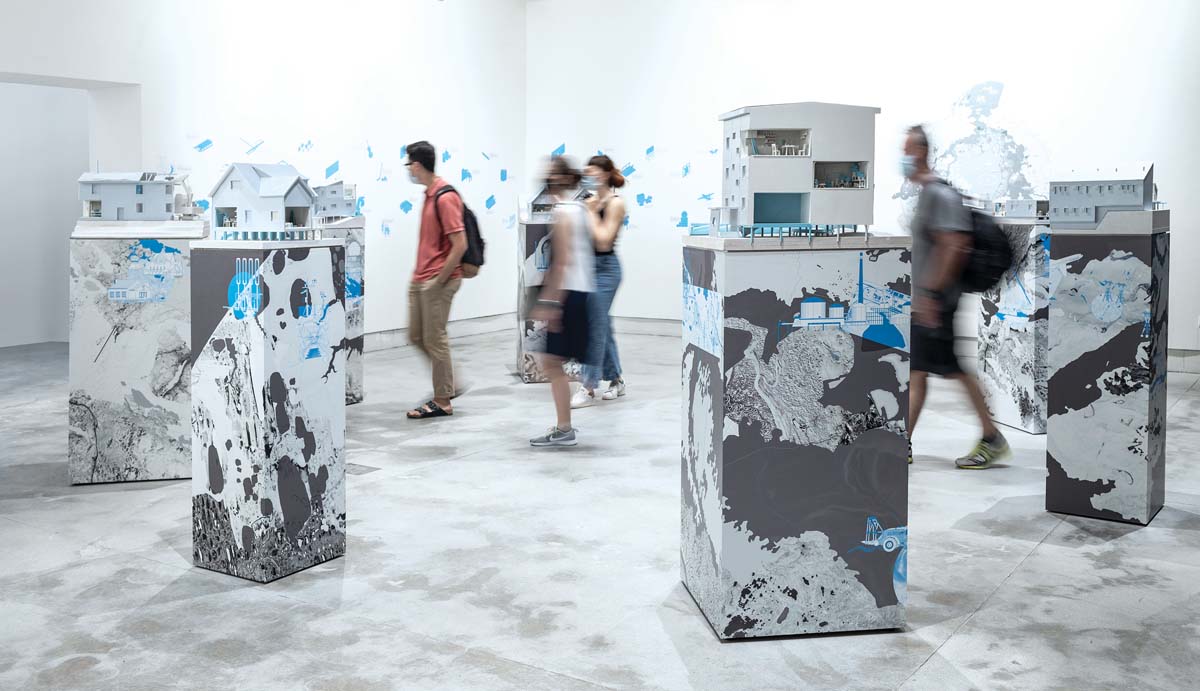Canada in Venice: Venice Biennale 2021
Canadian Architects lead three exhibitions at the venice biennale, tackling the theme: How will we live together?

A year late and amid pandemic restrictions, the 17th International Architecture Exhibition of La Biennale di Venezia opened this summer. The opening brought a muted version of the regular fanfare, and the exhibition’s theme—“How Will We Live Together?”—tackles a correspondingly serious set of questions.
Canadian architects and designers have taken up the enormous task of responding to this prompt, in several different ways. Canada’s official entry to the Biennale, Imposter Cities, was commissioned by the Canada Council for the Arts and co-curated by McGill professor David Theodore and Montreal-based firm T B A / Thomas Balaban Architect. In addition, Canada also has a presence in the Central Pavilion, with the project Contested Circumpolar: Domestic Territories, developed by Toronto-based Lateral Office with Arctic Design Group. The Arsenale is graced with Grove, a large-scale installation by Toronto’s Philip Beesley with Living Architecture Systems Group.

This year’s selections did not go unscathed by the effects of the pandemic, and many exhibitors found ways to rethink and reformulate their exhibitions. Impostor Cities developed a hybrid exhibition that offers an outdoors-only experience in Venice, paired with a content-rich online site. Both versions describe Canadian cities that stand in for well-known international destinations in film and television. It exposes a quirky aspect of the country’s architectural identity—Canadian structures are remarkably good at “faking it,” representing places other than themselves.
While travel restriction have made it difficult for visitors to attend the Biennale, those that make it here will immediately spot the iconic Canadian pavilion. It’s usually hidden between trees and dwarfed by its neoclassical neighbours at the Giardini grounds, but this year, the building has been partially wrapped in a lively shade of green, emphasizing its unique form.
The green fabric allows for the use of chroma technology to create an augmented reality experience. A smartphone aimed at the building activates an Instagram filter, which transforms the building into a range of Canadian landmarks from the curatorial team’s film library. With Venice as its backdrop, the visitor can catch a glimpse of Arthur Erickson’s Simon Fraser University in Burnaby, BC, or Louise Bourgeois’ Maman, a looming sculpture of a giant spider that sits outside Moshe Safdie’s National Art Gallery in Ottawa. The building itself becomes an impostor—an experience that is singular to each visitor in Venice, but also global once it is shared on social media platforms.
The Giardini’s main building, the Central Pavilion, houses installations directly chosen by the Biennale’s guest curator; this year, Lebanese architect Hashim Sarkis. By focusing on the global commons, Sarkis critically examines the political boundaries and economic interests that shape architecture.

As part of the Central Pavilion, Sarkis invited Lateral Office to build upon their research on Nunavut, originally presented at the 14th Architecture Biennale in 2014. Created with Arctic Design Group, the exhibition Contested Circumpolar: Domestic Territories expands Lateral Office’s earlier research to encompass the global Arctic. The installation presents maquettes of domestic life representing the eight nations that have land claims in the Arctic: Canada, Finland, Greenland, Iceland, Norway, Russia, Sweden and the United States. While the Arctic is home to many Indigenous groups, the region is shaped by territorial claims, resource extraction, climate change and political interests that have strongly influenced the way in which people live, including their domestic spaces.
Arranged in a circular manner, eight plinths are wrapped in maps that reveal geographical data and local flora and fauna, alongside particularities of northern life such as open dumps, refineries, and geo-political markers like DEW radar stations. The plinths are each topped with a detailed house model, exposing the intimacies of domestic life: from slippers on the floor to freshly slaughtered meat on the kitchen table. The housing samples vary in size and form, with mechanical systems on view in some, and others purposefully modelled to reflect the level of disrepair of local housing stock.

Alongside the models, the walls of the exhibition space are lined with further explanatory graphics. These describe specific aspects of Arctic life, such as communication limitations in the north, which is largely reliant on dial-up or weak satellite connections at extremely high costs. Residents of the Arctic must also contend with pollution from mineral extraction sites and refineries, challenges with waste management, an array of transportation systems adapted to seasonal change, and the tradeoffs between sometimes-hazardous local food practices and costly imported food.
The nations of the circumpolar Arctic share a common territory, but the exhibition makes it clear that each is also distinct, having been molded from specific political and economic influences.
Turning to the Arsenale space, Grove, an installation by Philip Beesley and Living Architecture Systems Group, offers a much larger narrative frame of reference—examining metaphysical questions of how we live, dwell, and die.

Nestled next to exhibitions on molecular and bee architecture, Grove hovers over visitors as an interlaced canopy of intricate, lightweight meshwork and droplet spires. It’s a multi-sensory island, with an entanglement of air, water and light coupled with sound totems that breathe life into the surroundings. At the centre of this delicate space, the film Grove Cradle, by Warren du Preez and Nick Thornton Jones, is projected onto the floor. Images of water, ice formations, snow, and a child-like being appear, moving through cycles of light and darkness. The sound—both from the film and the pillar speakers—draws visitors further into the space.
The installation suggests a new world where architecture collaborates with plants and animals, has no national boundaries, and is constantly shared and inclusive. The form of this new world takes inspiration from natural structures—cloudscapes and snowflakes, water and plants—to create buildings that are both rigid and sensitive to their environment, as evoked by Grove’s lace-like canopy.

At varying scales, responding to the question of how we will live together is a task that involves study and reflection on how we live now. It’s a daunting endeavour—not only for curators presenting work in Venice, but for all architects, designers and builders. How do we live, apart and together? How should we live? How can we remedy the errors of our architectural pasts, and envision something new together?
Natalia Woldarsky Meneses is a Canadian architect based in Bologna, Italy.
